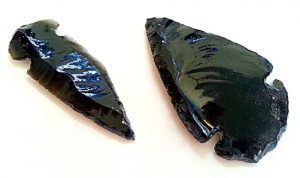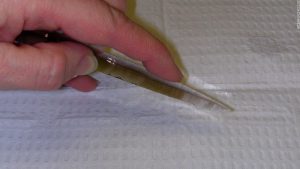Since ancient times, obsidian rock has been useful in tool making, as well as serving many other purposes. Obsidian is an igneous rock which is rich in silica and has a low water content. It appears black and shiny in its pure form but is often covered in an outer layer that is more brown in color and appears dull and rough. Obsidian rock was used by early human civilizations to create tools such as arrowheads, blades, and other sharp objects. It is also suggested that obsidian tool knapping could have been used in some cultures as a way for male knappers to impress potential female partners. Using knapping- the creation of stone tools by way of percussion- early humans were able to produce almost-modern objects, some of which are still being utilized today.

Two arrowheads produced from obsidian through the process of knapping. Arrowheads would only be found in areas where hunting by bow and arrow was prevalent.
Obsidian is especially useful for its sharp properties, and this is the reason obsidian tools are still on the market and being studied and used in the twenty first century. Obsidian has incredibly useful and unique properties. The average household razor blade is somewhere between 300 and 600 angstroms (unit of measurement used to measure blade fineness). An obsidian blade measures in at only 30 angstroms, making it very useful in precise cutting. For its extreme sharpness, modern surgeons have continued to utilize obsidian tools in their work, especially in precise surgeries.
Specifically, Dr. Lee Green at the Department of Family Medicine at the University of Alberta says it is not uncommon for him to use obsidian blades in his work. Obsidian’s makeup creates a smooth and continuous edge on a blade, while regular steel tools have a rough edge on their blades at a microscopic level, which can tear into tissue and leave the patient with a longer healing process and more intense scarring. Green has observed that following procedures with obsidian scalpels, patients experience much less scarring than in the same procedure done with steel tools.
While it may seem odd to be using tools from the stone age in modern medicine, the blades being used today are different than those of ancient humans. Dr. Green receives his obsidian scalpels from an expert flint knapper, Errett Callahan. Green also knows that using obsidian in medicine is a technique is not useful for every procedure and for every surgeon. Obsidian tools have their time and place. The scalpels can also be helpful for patients who might be allergic to the materials used for most surgical tools, such as steel and metal.
Sources:
Shadbolt, Peter. “How Stone Age Blades Still Cut It in Surgery.” CNN, Cable News Network, 2 Apr. 2015, www.cnn.com/2015/04/02/health/surgery-scalpels-obsidian/index.html.
King, Hobart M. “Obsidian.” Geology, geology.com/rocks/obsidian.shtml.
Britannica, The Editors of Encyclopaedia. “Obsidian.” Encyclopædia Britannica, Encyclopædia Britannica, Inc., 10 May 2018, www.britannica.com/science/obsidian.
Additional Readings/videos
https://www.ncbi.nlm.nih.gov/pubmed/8415970
Pictures:
https://www.spectrum-scientifics.com/Obsidian-Replica-Arrowhead-p/5826.htm
https://www.cnn.com/2015/04/02/health/surgery-scalpels-obsidian/index.html


What would you say this means about the word ‘modern’ then? How can we call Native peoples of the past un-modern when, in fact, the technology of today that is still being used comes directly from their work and archaeologists emulating their work: we advanced, made metals that were stronger and more ‘complex,’ yet we return to obsidian and flintknapping because of its preciseness. Instead of moving forward like progress should, like modernity should, we’ve moved in a circle, going back to an old technology. How can we be modern, then, if we are using un-modern techniques?